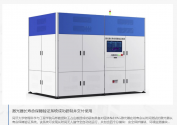You are using an out of date browser. It may not display this or other websites correctly.
You should upgrade or use an alternative browser.
You should upgrade or use an alternative browser.
News on China's scientific and technological development.
- Thread starter Quickie
- Start date
China had major breakthrough in all solid state lithium batteries. The new battery can retain 80% of capacity after 5000 recharge cycles. Battery volume only increases by 1.2% during discharge. Energy density reaches 390 Wh/kg, 30% higher than the previous reported record.
研究团队通过调控LiTi2(PS4)3的电导率和充放电容量,成功合成出兼具高离子电导率(0.2 mS cm−1)、高电子电导率(225 mS cm−1)和高放电比容量(250 mA h g−1)的Li1.75Ti2(Ge0.25P0.75S3.8Se0.2)3。该材料的离子和电子电导率高于传统层状氧化物正极材料1000倍以上,比容量超过目前的高镍正极材料。
同时,该材料在充放电过程中仅发生1.2%的体积形变,低于传统层状氧化物正极材料的50%。高的电导率可确保正极在不添加导电助剂的情况下正常充放电,低的体积形变保证了电池在充放电过程中结构的稳定性。以100%活性材料构筑的全固态锂电池在5000圈循环后保持初始容量的80%,其390 Wh/kg的高能量密度是目前所报道长循环全固态锂电池的1.3倍。
PiSigma
"the engineer"
My FiL just had 4 arteries unblocked last week they were 70-90% blocked. Foot long cut on chest so a 4 months recovery. This is what happens to people that is 300 lbs and only exercise is golf. He lost 40 lbs one time and I didn't even noticed!I hope China will develop a device to clear blocked arteries with one treatment without invasive surgery, thus obsoleting balloon angioplasty. Demand for such machines will be high and factory production lines will resemble dumpling factories to meet Western demand, especially in the US whose people can then continue to gorge on their 2500kcal lunch.
So now I'm in Texas for a few more days.
The laser long life assurance verification system was successfully developed and put into use.
the School of Physical Science and Engineering at Tongji University have successfully developed a laser long-life assurance verification system that can perform long-term online life tests on solid-state Nd:YAG lasers. The system can achieve long-term unattended fully automated operation and consists of four sub-modules: safety protection module, environmental monitoring module, beam measurement module, and transmission characteristic module. It has a total of more than 40 measurement parameters, 28 control units, 30 self-developed supporting programs, and 2 long-life operation system programs. The two sets of equipment have been delivered to the user unit in the early stage. After on-site installation, adjustment and calibration, they have successfully passed the on-site acceptance. After one year of stable operation, they have recently passed the acceptance of the superior competent department.

The system not only realizes the online life test of solid Nd:YAG laser, but also has multiple comprehensive test functions, especially in key indicators such as polarization degree, jitter and directivity, as well as full-aperture measurement. It is the main test equipment guarantee for aging test process flow, environmental test process flow, life test process flow and application test in laser development and practical application.
In addition, the system can realize unattended, automatic operation, control, detection, recording, and abnormal alarm functions. The system is designed to operate stably for more than one year. The main functions and features include:
(1) The system has 4 independent test modules, 26 core test parameters, and 40 independent test units. One or more test units can be flexibly selected for functional testing. The system has powerful control and storage functions. Each set of equipment adopts a combination of 3 industrial computers + 1 server. More than 100 data cables, control cables, and power cables are integrated and controlled. Each test unit is modularly and independently installed and laid out.
(2) The system can automatically complete the measurement of the internal temperature of the laser and the water flow of the chiller, the control of the laser shutter, the monitoring of environmental vibration, ambient temperature, ambient humidity and noise, and the real-time acquisition and display of multiple parameters such as laser energy, frequency, pulse width, wavelength, spectral line width, light field distribution, polarization degree, spot jitter, beam directivity, divergence angle, M2 factor analysis, etc. The maximum measurable laser beam diameter is 200mm, and it has the function of measuring one wavelength or multiple wavelengths simultaneously.
(3) The system database has automatic storage and statistical functions. In addition to the core parameters and trend graphs displayed in real time on the software display interface, the system software query function can automatically query the data and curves of a specific time period with one click, and perform statistical analysis on the data to form a test report; it can calculate the average value, maximum value, minimum value, and standard deviation of each parameter item to reflect the discrete degree of the laser performance parameters, thereby analyzing the laser performance.
(4) It can detect abnormal situations such as numerical deviation, data missing, software unresponsiveness, hardware unresponsiveness, etc., and has fault screening and system self-recovery functions; when abnormal data exceeds the set threshold and the fault cannot be eliminated, it has alarm and safety protection functions.
Sany factory here is lighthouse factory and fully automated.
smart mining using latest autonomous electric dump truck. 40% of China's mining is now done through smart mines.
Engineer
Major
Original video:
Sany factory here is lighthouse factory and fully automated.
I hope that is just a highlight of the most automated parts of those factories. Otherwise, it's a bit worrisome, because skill labors would be lost when there aren't anyone consistently doing those automated steps manually. You wouldn't be able to automate anything when you don't have people who know the process inside and out.
Japan went through the same issue in the 1980s. They went overboard with automation in vehicle factories. Then skilled workers started being laid off in droves and process knowledge started being lost. If you look at more recent Japanese vehicle factories they have much less automation. This is supposed to allow factories to be more flexible, for workers to have input into production and process improvement, and to retain skilled workers.I hope that is just a highlight of the most automated parts of those factories. Otherwise, it's a bit worrisome, because skill labors would be lost when there aren't anyone consistently doing those automated steps manually. You wouldn't be able to automate anything when you don't have people who know the process inside and out.
I hope they still retain at least some production lines or factories which are not fully automated.
